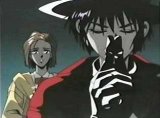

Quick Links:
Tokyo Babylon
Just as X/1999, Tokyo Babylon is anime based on some quality CLAMP manga. Tokyo Babylon as an anime series traces two cases handled by spirit medium Sumeragi Subaru and company. The episodes contain elements popularized in the American phenomena of X Files / Millenium / Profiler, with supernatural episodes presented in a modern environment from a more Japanese perspective of a pure spiritualist, instead of a Western (postcognitive) analyst. The kinds of mystic traditions presented in the magic of the series are perfect examples of the Japanese tradition of syncretic religion which the Meiji policy of shinbutsu bunri rei (literally, the separation of Buddha and kami) tried to deny, making the visual presentation somewhat more daring than an American audience might initially suspect.
The plot is nothing new for an audience familiar either with traditional folktale elements or with the aforementioned supernatural / psychological thriller variety of American show popular these days. The first volume deals with a rising company power, Nagumo Shinji, who seems to live a charmed life surrounded by the deaths of anyone close to him. This stereotype can either be seen as a blessing or a curse, and Nagumo views it as the former, believing himself to be chosen by Tokyo for especial greatness. The second volume deals with the much less interesting premise of a simple serial killer, supplemented by some interesting character development and side stories. Battles are more a celebration of the ability to use mystic powers than a showcase for innovative uses of magic. The plot overall is functional, with the first volume being much stronger than the second in presentation and premise, but felt more like an introduction to a series than two highlight movies. The second volume in particular felt more like an aside episode in a lengthy tv series than either a standalone movie or a sequel to the original.
The characters from this CLAMP production have potential, but never rise to their possible horizons. In the meantime, we are left with more traditional archetypes: the main character, Sumeragi Subaru is a kind young man who has powers which he does not fully exploit because of his compassion, and must end up being saved in the end by his more mysterious guardian / tutor. Said tutor in the meantime aspires to a fairly inconspicuous personality of a shy veterinarian as a "day job." Subaru’s sister, Hotoku, falls into a more cute and competent variant on the Mihoshi syndrome. There is some definite tension to the relationships, but the anime is too brief to approach the depth of this complexity.
The animation in Tokyo Babylon has that tv feel coupled with incredible attention to detail. A lot of the animation relies on minimal movement around the stills, but the clamp stills are very much worth panning the camera around! ^_^ The battle animation for the first volume is very strong for 1992, with some very intriguing symbolic presentations of the magic from the syncretic perspective mentioned before. The mysticism in itself is clearly Shinto at its very basis, but at the same time the spirit medium wears black, not the Shinto white, and has a cross of all things embroidered to his outfits, showing a synthesis not only of Taoist / Buddhist / Shinto elements, but also Christianity, more surprising by far given the way Buddhism and Shinto were both directed against Christianity (especially during the late Meiji period). There are flashes of pentagrams mixed with the use of guardian spirits, as well as more generic chanting and use of inscribed paper common in Buddhist, Taoist, and Shinto exorcisms. Furthermore, the costumes for Subaru and Hotoku can be quite striking at times, showing some interesting fashion "sense" at times. As a whole, though, the visual presentation was a lot stronger in volume 1, in spite of it being produced 2 years earlier than volume 2.
The music for Tokyo Babylon is quite impressive. The soundtrack is a very strong accompaniment to the presentation, with a pleasantly eclectic selection of themes and instruments. The listener is treated to quality variants on the modern cinematic genre of music: classical overtones supplemented with more modern instrumentality vectors, sometimes touching on jazz themes or the kind of creepiness one would expect from the X Files. The songs in the first volume seem a little off because of the constant tonal usage of British English by a Japanese singer... though the singing and pronunciation were almost perfect, certainly a long shot from the painful end song of Evangelion *shudder*. In contrast, the song ending the second volume was almost catchy. As a whole the orchestration rang with that subtle echo of inspiration often lacking in soundtracks.
Taken in toto, Tokyo Babylon is a strong introduction to CLAMP’s manga. Characters are presented in a digestible fashion, actually appreciable by those new to the series, unlike CLAMP’s later effort, X/1999. The plotlines may be fairly traditional, and the animation not as stunning as in X, but the overall visual presentation is quite a treat, especially to those interested in variations on Japanese mysticism. The perspective is sufficiently different from an X Files-esque presentation to avoid stymieing viewers jaundiced by the flood of supernatural thrillers in the West, but still involves enough stereotypes to bore the especially jaded or turn off the devotedly mundane.
Distributor: U.S. Manga Corps (CPM) Creator: CLAMP Released: 1992/1994
Plot: B Character Design: B Animation Quality: C++ Music: A Overall: B



